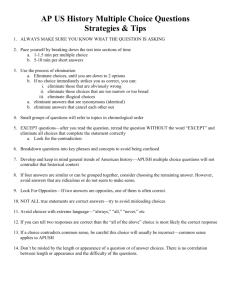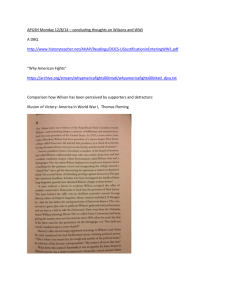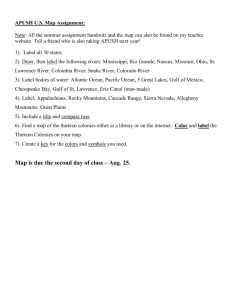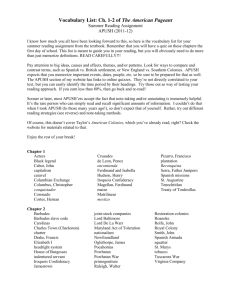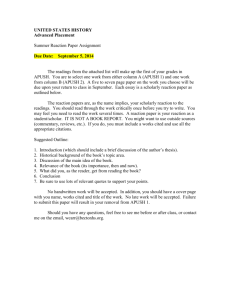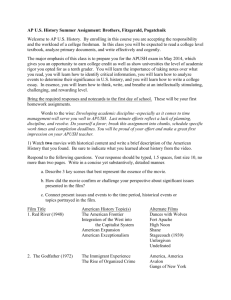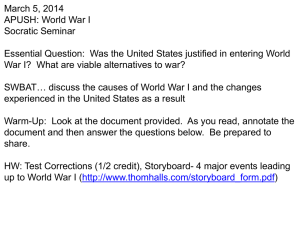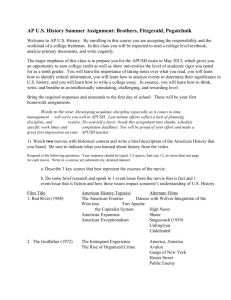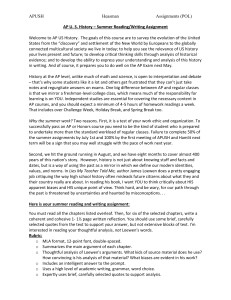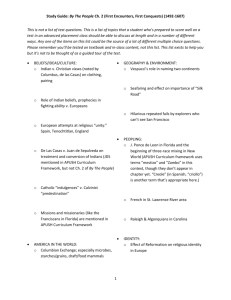AP US History
advertisement
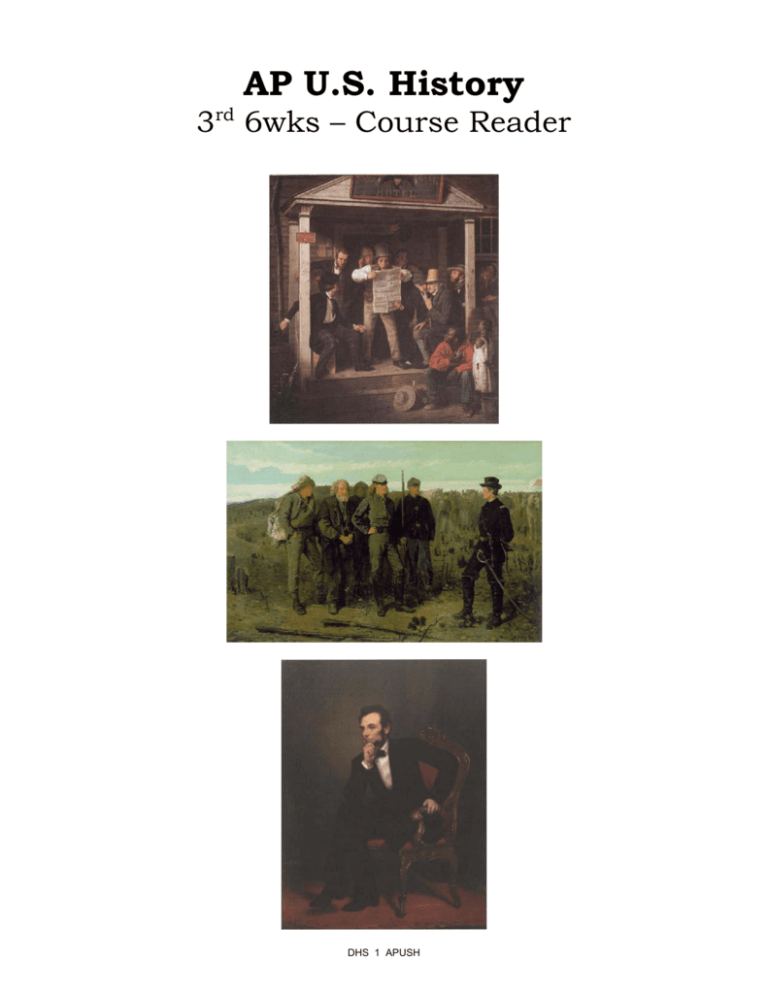
AP U.S. History 3rd 6wks – Course Reader DHS 1 APUSH APUSH - Third Six Weeks Date Day Topic / Content For Class Assessment Homework Nov. 7 Monday Test Review Test Review Nov. 8 Tuesday UNIT 7 TEST UNIT 7 TEST TEST Essay/Pass Back Test Quiz & Review, Note Cards, Ch. Questions Class Discussion ESSAY TOPIC: Manifest Destiny Read: Ch. 19 Nov. 9 Wednesday Review Test Nov. 10 Thursday Drifting Towards Disunion Nov. 11 Friday Drifting Towards Disunion QUIZ Nov. 14 Monday Secession Nov. 15 Tuesday Girding for War Seminar Quiz & Review, Notes Check, Ch. Questions Nov. 16 Wednesday EARLY RELEASE UNIT 8 ESSAY TEST UNIT 8 ESSAY TEST Nov. 17 Thursday Girding for War Class Discussion/Review for Test Nov. 18 Friday UNIT 8 TEST UNIT 8 TEST Nov. 21 Nov. 22 Nov. 23 Nov. 24 Nov. 25 Monday Tuesday Wednesday Thursday Friday Nov. 28 Monday The Furnace of War Nov. 29 Nov. 30 Tuesday Wednesday The Furnace of War Emancipation Proclamation Dec. 1 Thursday The Ordeal of Reconstruction Dec. 2 Friday The Ordeal of Reconstruction Quiz & Review, Notes Check, Ch. Questions Discussion Seminar Quiz & Review, Notes Check, Ch. Questions Class Discussion Dec. 5 Monday Ch. 21/22 Review Packet Review Packet Dec. 6 Tuesday UNIT 9 TEST UNIT 9 TEST Dec. 7 Dec. 8 Dec. 9 Wednesday Thursday Friday Review Test/ DBQ Wonderful World of DBQ Exam Review Introduce DBQ DBQ Dec. 12 Dec. 13 Dec. 14 Dec. 15 Dec. 16 End of 1st Semester Monday Tuesday Wednesday Thursday Exam Review EXAM WEEK EXAM WEEK EXAM WEEK Friday EXAM WEEK Jan. 2 Monday Staff In-service NO STUDENTS Jan. 3 Beginning of 2nd Semester Tuesday Political Paralysis in the Gilded Age Discussion Jan. 4 Wednesday Industry Comes of Age Discussion Jan. 5 Thursday Urbanization Discussion Jan. 6 Friday The Great West and Agricultural Revolution Discussion OpV 31 A & B Read: Ch. 20 QUIZ ESSAY TEST Read: Ch. 21 QUIZ Read: OpV 33 A & B Read: Ch. 22 QUIZ Bring Books to Class TEST Read: Ch. 23-26 Complete Study Guides DHS 2 APUSH Ch 23 Study Guide Ch 24 Study Guide Ch 25 Study Guide Ch 26 Study Guide Read: OpV 11A/B Washington/Dubois Chapter 19 Hinton R. Helper John Brown Charles Sumner John C. Fremont Dred Scott Roger Taney Jefferson Davis The Impending crisis of the South Uncle Tom's Cabin Lecompton Constitution Bleeding Kansas American party Lincoln‐Douglas Debates Freeport Doctrine Harper's Ferry raid Crittenden Compromise Chapter 21 John Wilkes Booth Robert E. Lee Thomas J. Jackson Ulysses S. Gran Grantt George McClellan David Farragut George Pickett Merrimack Monitor Emancipation Proclamation 13th Amendment Copperheads Battle of Antietam Gettysburg Peninsula Campaign March to the Sea Unit 8 Chapter 20 Napoleon III Maximilian Clara Barton William Seward Morrill Tarriff Act Trent affair Alabama Draft riots King Cotton Edwin M. Stanton National Banking Act Unit 9 Chapter 22 Andrew Johnson William Seward Freedmen's Bureau 10% Plan Wade‐Davis Bill Black Codes sharecropping 14th Amendment 15th Amendment Ex parte Milligan scalawags carpetbaggers Ku Klux Klan Seward' Folly DHS 3 APUSH DHS 4 APUSH DHS 5 APUSH DHS 6 APUSH DHS 7 APUSH DHS 8 APUSH DHS 9 APUSH DHS 10 APUSH DHS 11 APUSH DHS 12 APUSH DHS 13 APUSH DHS 14 APUSH CHAPTER 23: POLITICAL PARALYSIS IN THE GILDED AGE The "Bloody Shirt" Elects Grant 1. Was General Grant good presidential material? Why did he win? The Era of Good Stealings 2. "The Man in the Moon...had to hold his nose when passing over America." Explain. A Carnival of Corruption 3. Describe two major scandals that directly involved the Grant administration. The Liberal Republican Revolt of 1872 4. Why did Liberal Republicans nominate Horace Greeley for the presidency in 1872? Why was he a less than ideal candidate? Depression and Demands for Inflation 5. Why did some people want greenbacks and silver dollars? Why did others oppose these kinds of currency? Pallid Politics in the Gilded Age 6. Why was there such fierce competition between Democrats and Republicans in the Gilded Age if the parties agreed on most economic issues? The Hayes-Tilden Standoff, 1876 7. Why were the results of the 1876 election in doubt? DHS 15 APUSH The Compromise of 1877 and the End of Reconstruction 8. How did the end of Reconstruction affect African-Americans? The Birth of Jim Crow in the Post-Reconstruction South 9. Analyze the data in the lynching chart on page 513. Class Conflicts and Ethnic Clashes 10. What was the significance of the Great Railroad Strike of 1877? Garfield and Arthur 11. What new type of corruption resulted from the Pendleton Act? Makers of America: The Chinese 12. Why did most Chinese immigrants come to America? The Blaine-Cleveland Mudslingers of 1884 Romanism and Rebellion 13. Explain how character played a part in the presidential election of 1884. “Old Grover" Takes Over 14. Assess the following statement: "As president, Grover Cleveland governed as his previous record as governor indicated he would." Cleveland Battles for a Lower Tariff 15. What were the reasons behind Cleveland's stance in favor of lower tariffs? DHS 16 APUSH The Billion Dollar Congress 16. Explain why the tariff was detrimental to American farmers. The Drumbeat of Discontent 17. What was the most revolutionary aspect of the Populist platform? Defend your answer with evidence. Cleveland and Depression 18. What could Cleveland have done to lessen the impact of the financial turmoil? Cleveland Breeds a Backlash 19. Is the characterization of the Gilded Age presidents as the “forgettable presidents” a fair one? Explain. Identify: 1. Ulysses S. Grant 2. Boss Tweed 3. Graft 4. Credit Mobilier 5. Whiskey Ring 6. Gilded age 7. Stalwarts 8. Halfbreeds DHS 17 APUSH 9. Compromise of 1877 10. Plessy v. Ferguson 11. Chinese Exclusion Act 12. Jim Crow Laws 13. Mugwumps 14. James Garfield 15. Chester Arthur 16. Pendleton Act 17. Grover Cleveland 18. Sherman Silver Purchase Act 19. populists DHS 18 APUSH CHAPTER 24: INDUSTRY COMES OF AGE The Iron Colt Becomes an Iron Horse 1. What were the advantages and disadvantages of government subsidies for the railroads? Spanning the Continent with Rails 2. Describe how the first transcontinental railroad was built. Binding the Country with Railroad Ties 3. Explain how the railroads could help or hurt Americans. Railroad Consolidation and Mechanization 4. What technological improvements helped railroads? Revolution by Railways 5. What effects did the railroads have on America as a whole? Wrongdoing in Railroading 6. What wrongdoing were railroads guilty of? Government Bridles the Iron Horse 7. Was the Interstate Commerce Act an important piece of legislation? Miracles of Mechanization 8. What factors made industrial expansion possible? The Trust Titan Emerges 9. How did businesses organize to try to maximize profits? DHS 19 APUSH The Supremacy of Steel 10. Why was steel so important for industrialization? Carnegie and Other Sultans of Steel 11. Briefly describe the careers of Andrew Carnegie and J.P. Morgan. Rockefeller Grows an American Beauty Rose 12. How was John D. Rockefeller able to become so wealthy? The Gospel of Wealth 13. How did the wealthy justify their wealth? Government Tackles the Trust Evil 14. What two methods were tried by those who opposed the trusts? The South in the Age of Industry 15. How successful were Southerners at industrializing? The Impact of the New Industrial Revolution on America 16. Describe the positive and negative effects of the industrial revolution on working Americans. In Unions There is Strength 17. What conditions existed in America that led Jay Gould to say, "I can hire one half of the working class to kill the other half"? Labor Limps Along 18. Explain the similarities and differences between the National Labor Union and the Knights of Labor. DHS 20 APUSH Unhorsing the Knights of Labor 19. What factors led to the decline of the Knights of Labor? The AF of L to the Fore 20. How was the AFL different from previous unions? Makers of America: The Knights of Labor 21. Were the Knights conservative or revolutionary in their ideas? Identify: 1. Cornelius Vanderbilt 2. Alexander Graham Bell 3. Andrew Carnegie 4. John D. Rockefeller 5. Samuel Gompers 6. Land grant 7. Plutocracy 8. Vertical integration 9. Horizontal integration 10. Grange 11. Bessemer Process 12. Haymarket Riot 13. Trust DHS 21 APUSH CHAPTER 25: AMERICA MOVES TO THE CITY The Urban Frontier 1. What factors led to the growth of cities in the second half of the 1800's? The New Immigration 2. How were the new immigrants different from the old immigrants? Southern Europe Uprooted 3. Why did the new immigrants come to America in such large numbers? Makers of America: The Italians 4. How did Italian immigrants live their lives in America? Reactions to the New Immigration 5. How did political bosses help immigrants? Narrowing the Welcome Mat 6. In 1886, what was ironic about the words inscribed on the base of the Statue of Liberty? Churches Confront the Urban Challenge 7. What role did religion play in helping the urban poor? Darwin Disrupts the Churches 8. What effect did the theory of evolution have on Christian churches? The Lust for Learning 9. What advances took place in education in the years following the Civil War? DHS 22 APUSH Booker T. Washington and Education for Black People 10. Explain the differences in belief between Booker T. Washington and W.E.B. Du Bois. The Hallowed Halls of Ivy 11. What factors allowed the number of college students to dramatically increase? The March of the Mind 12. Describe some of the intellectual achievements of the late 1800’s. The Appeal of the Press 13. How did the ability to produce newspapers inexpensively change their content? Apostles of Reform 14. How did writers in the 1870's and 1880's try to address the problems of their time? Postwar Writing 15. Did the trends in writing after the Civil War make it a good period for literature? Explain. Literary Landmarks 16. What did many writers in the late 1800's have in common? The New Morality 17. What evidence demonstrated a battle raging over sexual morality? Families and Women in the City 18. What changes were occurring in the women's rights movement? Prohibition of Alcohol and Social Progress 19. What social causes were women (and many men) involved in the late 1800's? DHS 23 APUSH Artistic Triumphs 20. Why is this section titled "artistic triumphs?" The Business of Amusement 21. What forms of recreation became popular from 1870 to 1900? Identify 1. Jane Addams 2. Charles Darwin 3. Booker T. Washington 4. W.E.B. DuBois 5. Horatio Alger 6. Mark Twain 7. Carrie Chatman Catt 8. Florence Kelley 9. Settlement house 10. Pragmatism 11. Yellow journalism 12. Social gospel 13. Hull House 14. Morrill Act 15. Women’s Christian Temperance Movement 16. 18th Amendment DHS 24 APUSH CHAPTER 26: THE GREAT WEST AND THE AGRICULTURAL REVOLUTION The Clash of Cultures on the Plain 1. Describe the effect of westward expansion on Native Americans. Receding Native Americans 2. How was the West "won?" Bellowing Herds of Bison 3. How were the Buffalo reduced from 15 million to less than a thousand? The End of the Trail 4. What did the government do to try to assimilate Native Americans? Mining: From Dishpan to Ore Breaker 5. How did the discovery of precious metals affect the American West? Beef Bonanzas and the Long Drive 7. Why was cattle ranching so profitable in the 1870's? The Farmers’ Frontier 8. Did the Homestead Act live up to its purpose of giving small farmers a descent life on the plains? The Far West Comes of Age 9. What were some milestones in the “closing” of the West? DHS 25 APUSH The Fading Frontier 10. What effects has the frontier had on the development of the United States? The Farm Becomes a Factory 11. Explain the statement, "The amazing mechanization of agriculture in the postwar years was almost as striking as the mechanization of industry." Deflation Dooms the Debtor th 12. What problems faced farmers in the closing decades of the 19 century? Unhappy Farmers 13. How did nature, government, and business all harm farmers? The Farmers Take Their Stand 14. How did the Grange attempt to help farmers? Prelude to Populism 15. What steps did the Farmers’ Alliance believe would help farmers? Coxey’s Army and the Pullman Strike 16. Why did President Cleveland send in federal troops during the Pullman Strike? Golden McKinley and Sliver Bryan Know: Mark Hannah, William McKinley, William Jennings Bryan, Cross of Gold speech 17. Was William McKinley a strong presidential candidate? Explain. Class Conflict: Plowholders versus Bondholders 18. “The free-silver election of 1896 was probably the most significant since Lincoln’s victories in 1860 and 1864.” Explain. DHS 26 APUSH Republican Standpattism Enthroned 19. Did McKinley possess the characteristics necessary to be an effective president? Identify 1. Sitting Bull 2. George Custer 3. Eugene V. Debs 4. William McKinley 5. William Jennings Bryan 6. Battle of Wounded Knee 7. Dawes Severalty Act 8. Buffalo Soldiers 9. Homestead Act 10. Granger laws 11. Populist Party 12. Pullman Strike 13. Cross of Gold speech 14. Dingley Tariff bill 15. Gold Standard Act DHS 27 APUSH
